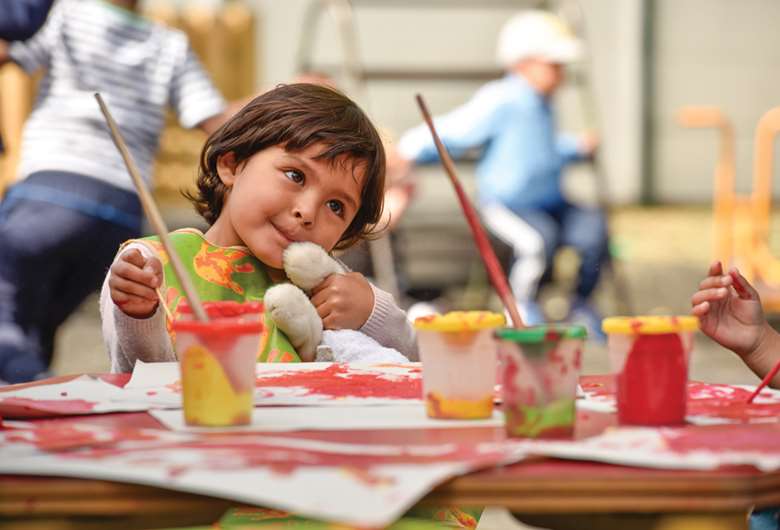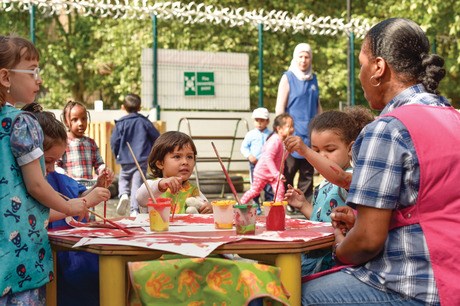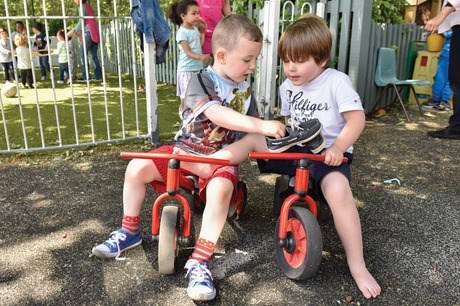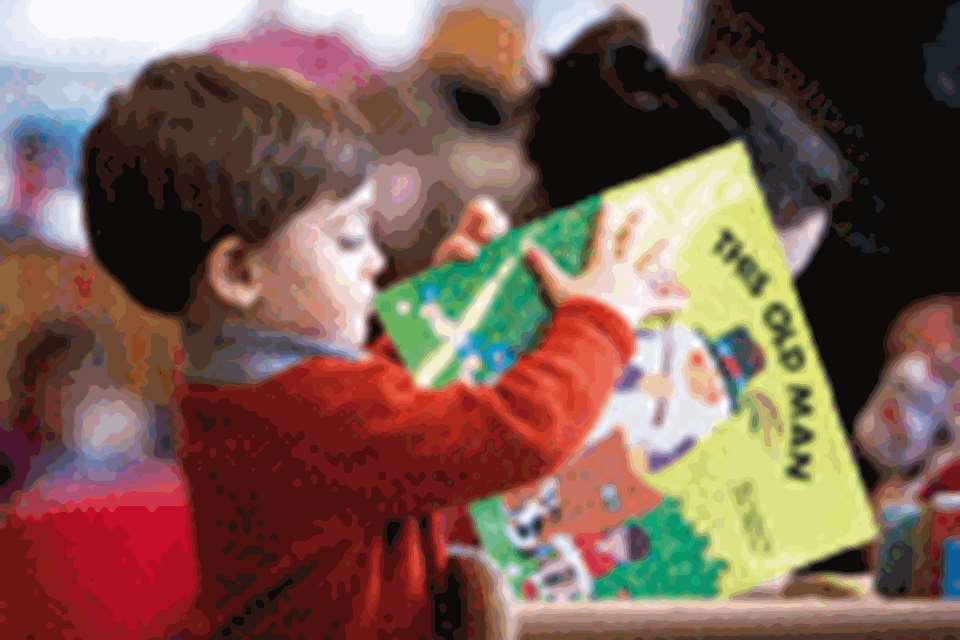Learning & Development: Communication & Language - Up to speed
Professor Caroline Rowland and Dr Michelle Peter
Monday, June 15, 2015
A 'language-rich' environment both at home and in the nursery is vital if a child is to progress easily through the many stages of early speech development. In the first of a series on communication and language, Professor Caroline Rowland and Dr Michelle Peter explain why.

Children differ enormously in how quickly they learn to talk. Some children are faster than others, producing their first words before one year of age. In fact, some children speak before they can crawl. Some are adventurous at combining words, producing full sentences early in life, though these are often peppered with grammatical errors. Others seem more cautious, only combining words when they are absolutely sure they have the grammar right.
The fastest children not only start learning words earlier, they also learn more words per day than the slowest children 1. At 18 months of age, the fastest American children know more than 320 words on the MacArthur-Bates language checklist, yet the slowest only know four. The difference between fast and slow language learners is, therefore, not trivial. (Explore the data on the CLEX database at www.cdi-clex.org.)
Most of the time, these differen- ces are not worrying. Many children eventually catch up. In fact, a large number of children identified as 'late talkers' at age three end up with language ability within the normal range by age six (although a few weaknesses remain 2). In addition, many of the differences between fast and slow learners are beyond our control; second-born children, for example, often develop language more slowly than first-borns simply because they have to share their parents' attention with their older sibling 3.
Sometimes, however, slow language learning is more of a problem. Clearly, children with a physical barrier to language learning such as a hearing impairment or a cognitive disability such as Down syndrome, will need specialist help from speech and language therapy teams. However, it is also the case that some children are delayed simply because they do not receive enough language stimulation in their everyday lives 4. For these children, simply providing a language-enriched environment in nurseries and pre-schools, and encouraging parents to do the same in the home, can be of huge benefit.
ACHIEVING THE MAJOR MILESTONES
The process of acquiring a language involves a number of complex tasks, each of which has to be mastered in turn during the early years (see box). At each stage of the process, children need a stimulating language-rich environment. However, what we mean by a language-rich environment can differ depending on what part of language children are trying to master.
Sounds
For example, before they can start to produce words, children have to learn to distinguish, and produce, speech sounds like 'ba', 'pa', 'da'. This is a key milestone - if children can't distinguish between a pa and a ba, they will never be able to distinguish between words like pat and bat (a very important skill if someone has just told you to pat the dog).
However, all languages contain slightly different sets of speech sounds (for example, Japanese does not distinguish between 'r' and 'l'), which means that children need to hear a lot of speech to tune into the sound of their language 5. During this process, errors in pronunciation are common, and perfectly normal for a while (for example, broke becomes bok, that becomes da, doggy becomes goggy) 6. So, babies benefit enormously from practising sounds in their babble.
A good strategy is to leave gaps in talk for children to take their turn in the conversation - even if it is just with a gurgle, a coo or a bit of babble. Using a lively voice, with ups and downs, also helps babies tune into the sounds of their language 7.
Words
Once they have learned speech sounds, children then have to learn to combine the sounds into meaningful words. This is harder than we might think. Imagine a scenario where a rabbit scampers across a field and someone shouts 'Look, a rabbit!' How do children work out the meaning of the word rabbit from that sentence? It could refer to the rabbit, but it could just as easily mean animal, mammal, grass, running or even dinner. Matching words to their meanings can be difficult.
To narrow down the correct meaning, children need to hear new words frequently in lots of different contexts (for example, they need to hear the word 'rabbit' when looking at rabbits running, standing still, in fields, in hutches, in books, on TV). This is why it is so important to talk a lot with children; the more we talk, the more often we repeat words in different contexts the easier it is to narrow down the correct meaning of words. In fact, one study found that 18-month-olds who hear a lot of speech can be up to six months ahead of their peers 8.
Sentences
Once children have learned some words, they then need to learn to fit them together into grammatical sentences. To do this, they have to learn that changes in sentence meaning may be signalled by sequencing words in different ways ('man bites dog' does not mean the same as 'dog bites man', even though both sentences contain the same words).
Children also have to learn that adding certain endings to words changes their meaning in precise but subtle ways - for example, by turning 'kick' into 'kicked' we indicate that the kicking action took place in the past.
When older children are learning grammar, it can sometimes be a good idea to challenge them by using language that is slightly beyond their current capabilities. For example, one study reported that four-year-olds whose parents produced a lot of complex sentences (for example, sentences with two verbs such as 'He thought Abi made a mistake') became better at understanding and producing complex grammar faster 9.
Interestingly, teachers' speech has a similar effect in the classroom. Since there is no genetic relationship between the teacher and the children in their class, the improvement in children's language here can only be caused by the enriched language used by the teacher.

HELPING THE BRAIN LEARN LANGUAGE
So, a language-enriched environment can help children learn the sounds, words and grammar of their language. However, to truly understand the importance of the environment, we have to look a little deeper into the brain. Language learning happens because our brains contain a number of complex interacting systems - cognitive systems - which work together to learn different aspects of language. Each of these systems benefits from a language-rich environment.
Auditory and visual systems
For example, the auditory (hearing) system is clearly involved in learning a language. The auditory cortex of the brain receives speech sounds from the ear and turns them into meaningful language. But the other senses are also crucial, especially the visual (seeing) system, which helps children match words to the correct objects or actions. This is why language learning can often be difficult for children with sight loss. For example, to learn the word 'dog', a child with sight loss may need to spend a lot of time with dogs - stroking them, hearing them bark, feeling their shape - in order to understand exactly what a 'dog' is 10.
Attention system
The attention system is also important. Children cannot learn a word if they are not paying attention both to the speaker and to the word's referent (what it refers to) when the word is spoken. Here, too, the child's caregivers can play a big role. For example, children learn words for objects much more easily if they hear the word at the precise moment when they are paying attention to the word's referent.
Two important features are:
- 'semantic contingency': talking about what the child is already focused on (not directing her to something over the other side of the room), and
- 'temporal contingency': responding immediately to what the child is focused on (within two seconds).
One study found that children whose parents used a lot of contingent behaviour when they were nine months old had significantly larger vocabularies six months later 11.
Memory processing
Memory and processing are also important. To learn language, children have to memorise a lot of sounds, words, phrases and rules of grammar, and this takes time and a lot of practice. However, they also have to process words and sentences to work out what they mean. Hearing words repeatedly is crucial for this.
We can study processing using a 'looking while listening' procedure; this allows us to test how babies process words by measuring how quickly they shift their eyes to look at an object when it is named (for example, they might see an apple and an orange and hear 'Ooh, look at the apple').
Using this procedure, one research group has found that children who heard more words and sentences at 18 months of age were faster to process words seven months later 12. This in turn had a knock-on effect on their vocabulary learning; fast-processing 25-month-olds had larger vocabularies six years later. So, language-rich environments don't just help children learn words; they can initiate changes in the brain that continue to give children an advantage, years later.
Professor Caroline Rowland and Dr Michelle Peter are based at the University of Liverpool, supported by the ESRC International Centre for Language and Communicative Development, www.lucid.ac.uk
The next article in this series(13-26 July) will explain how children learn words and the impact of the environment on the learning process

MAJOR MILESTONES IN LANGUAGE DEVELOPMENT
By 12 months
- Listens carefully and turns to someone talking on the other side of the room.
- Babbles strings of sounds, like 'no-no' and 'go-go'.
- Makes noises, points and looks at you to get attention.
- Recognises some words, like 'bye bye', 'car' and 'daddy'.
- Enjoys action songs and rhymes and gets excited when sung to.
- Takes turns in conversations, babbling back to an adult.
By 18 months
- Starts to understand simple instructions like 'kiss mummy', 'kick ball' and 'give me'.
- Points to things when asked, like familiar people or objects such as 'book' and 'car'.
- Uses up to 20 simple words, such as 'cup', 'daddy' and 'dog'.
- Gestures or points, often with words or sounds, to show what they want.
By two years
- Understands between 200 and 500 words and uses 50 or more single words.
- Understands more simple questions and instructions. For example, 'Where is your shoe?' and 'Show me your nose'.
- Starts to put short sentences together with two to three words, such as 'more juice'
- or 'bye nanny'.
By three years
- Understands longer instructions, such as 'make teddy jump' or 'where's mummy's coat?'
- Understands simple 'who', 'what' and 'where' questions.
- Uses up to 300 words.
- Puts four or five words together to make short sentences, such as 'I want more juice please'.
- Asks lots of questions.
- Starts to use simple plurals by adding 's', for example 'shoes' or 'cars'.
- Uses a wider range of speech sounds, but may have problems with sounds like 'sh', 'ch', 'th' and 'r'.
By four years
- Understands and often uses colour, number and time-related words, for example, 'red', 'three', 'tomorrow'.
- Is able to ask and answer questions about 'why' something has happened.
- Uses longer sentences and links sentences together.
- Describes events that have already happened (for example, 'we went park').
- Starts to like simple jokes.
- Stills makes mistakes with tense such as saying 'runned' for 'ran'.
By five years
- Understands spoken instructions without stopping what they are doing.
- Takes turns in much longer conversations.
- Understands more complicated language such as 'first', 'last', 'might', 'may be' and 'above'.
- Understands words that describe sequences such as 'First we are going to the shop; next we will play in the park'.
- Uses sentences that are well formed, but may still have some difficulties with grammar (for example, saying 'sheeps' instead of 'sheep').
- Uses most sounds effectively but may have some difficulties with more difficult words such as 'scribble'.
Taken from ICAN's Talking Point website. For a more detailed summary, visit www.talkingpoint.org.uk/ages-and-stages
COGNITIVE SYSTEMS
Various cognitive systems are involved in langauge learning. To learn sounds, words, grammar and communicate, a child must:
- match what they hear to what they see (auditory and visual system)
- remember what they hear and see (memory system)
- link words to their meaning (processing system)
- pay attention to what people are saying (attention system)
- interpret the message (inferencing system).
TALKING TIPS
Children differ enormously in how quickly they reach language milestones. Sometimes a language-rich environment can help slower children catch up.
- Help children learn speech sound by giving them the space to practise their babble.
- Help children learn words by using them frequently, in lots of different contexts.
- Help older children learn grammar by modelling a range of complex sentence structures.
- Language learning happens because our brains contain a number of interacting cognitive systems, each of which benefits from a language-rich environment.
- Help children learn to match the words they hear to the objects and actions they see by labelling them every time you see them.
- Pay attention to children's focus of attention; talk about what they are currently looking at and engaged with.
- Remember that children have to work out what words mean as well as memorise them. Give them plenty of opportunities to pick up on and learn the meaning of words.
REFERENCES
- Fenson, L, Marchman, VA, Thal, DJ, Dale, PS, Reznick, JS, Bathes, E (2006). The MacArthur-Bates Communicative Development Inventories User’s Guide and Technical Manual, Second, Edition. Baltimore : Paul H. Brokes Publishing Co.
- Rescorla L (2002). Language and reading outcomes to age 9 in late-talking toddlers. Journal of Speech, Language, and Hearing Research, 45, 360–371
- Hoff-Ginsberg, E (1998). The relation of birth order and socioeconomic status to children's language experience and language development. Applied Psycholinguistics, 19, 603-629.
- Law J, Todd, L, Clark, J, Mroz, M and Carr J. (2013) Early language delays in the UK. London: Save the Children report.
- Werker, JF, & Tees, RC (1984). Cross-language speech perception: Evidence for perceptual reorganization during the first year of life. Infant Behavior and Development, 7, 49-63.
- Vihman, MM (1996). Phonological development: The origins of language in the child. Oxford: Basil Blackwell.
- Thiessen, ED, Hill, EA, & Saffran, J. R. (2005). Infant-directed speech facilitates word segmentation. Infancy, 7(1), 53-71
- Weisleder, A, & Fernald, A (2013). Talking to children matters: Early language experience strengthens processing and builds vocabulary. Psychological Science, 24(11), 2143-2152.
- Huttenlocher, J, Vasilyeva, M, Cymerman, E, & Levine, S (2002). Language input at home and at school: Relation to child syntax. Cognitive Psychology, 45(3), 337–374.
- Landau, B, & Gleitman, LR (1985). Language and experience: Evidence from the blind child. Cambridge MA: Harvard University Press.
- McGillion, M, Pine, J, Herbert, J & Matthews, D. (2014). A training study to promote contingent talk and test its effect on language development. Paper presented at the 13th International Congress for the Study of Child Language, Amsterdam, The Netherlands. Retrieved from www.iascl2014.org/files/7014/0508/9102/Symposia_final.pdf.
- Marchman, VA, & Fernald, A (2008). Speed of word recognition and vocabulary knowledge in infancy predict cognitive and language outcomes in later childhood. Developmental Science, 11(3), F9-F16.










